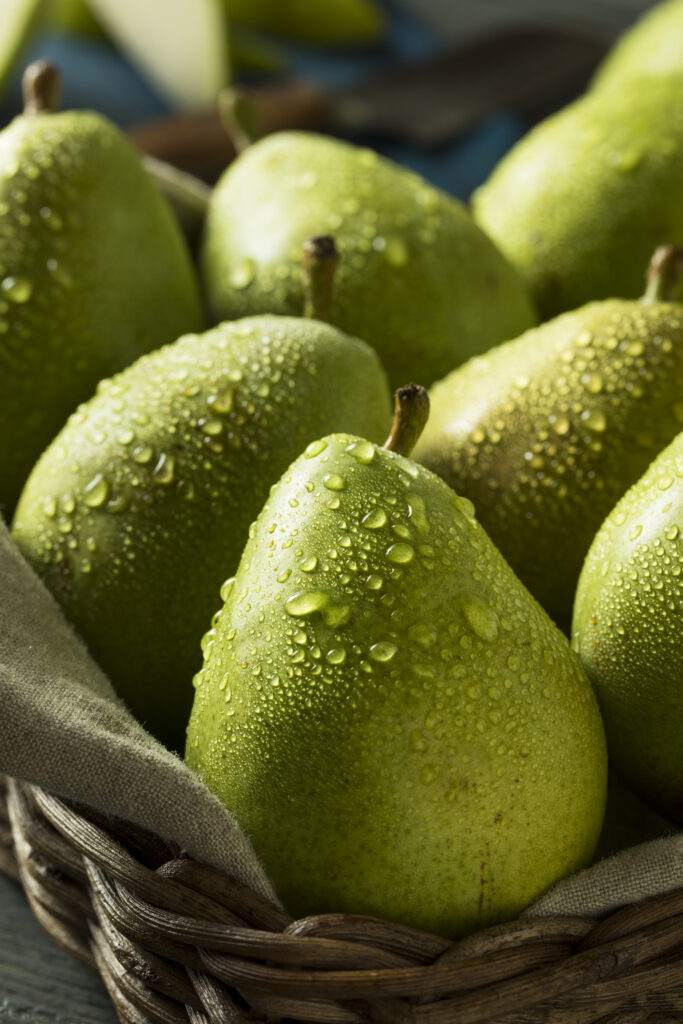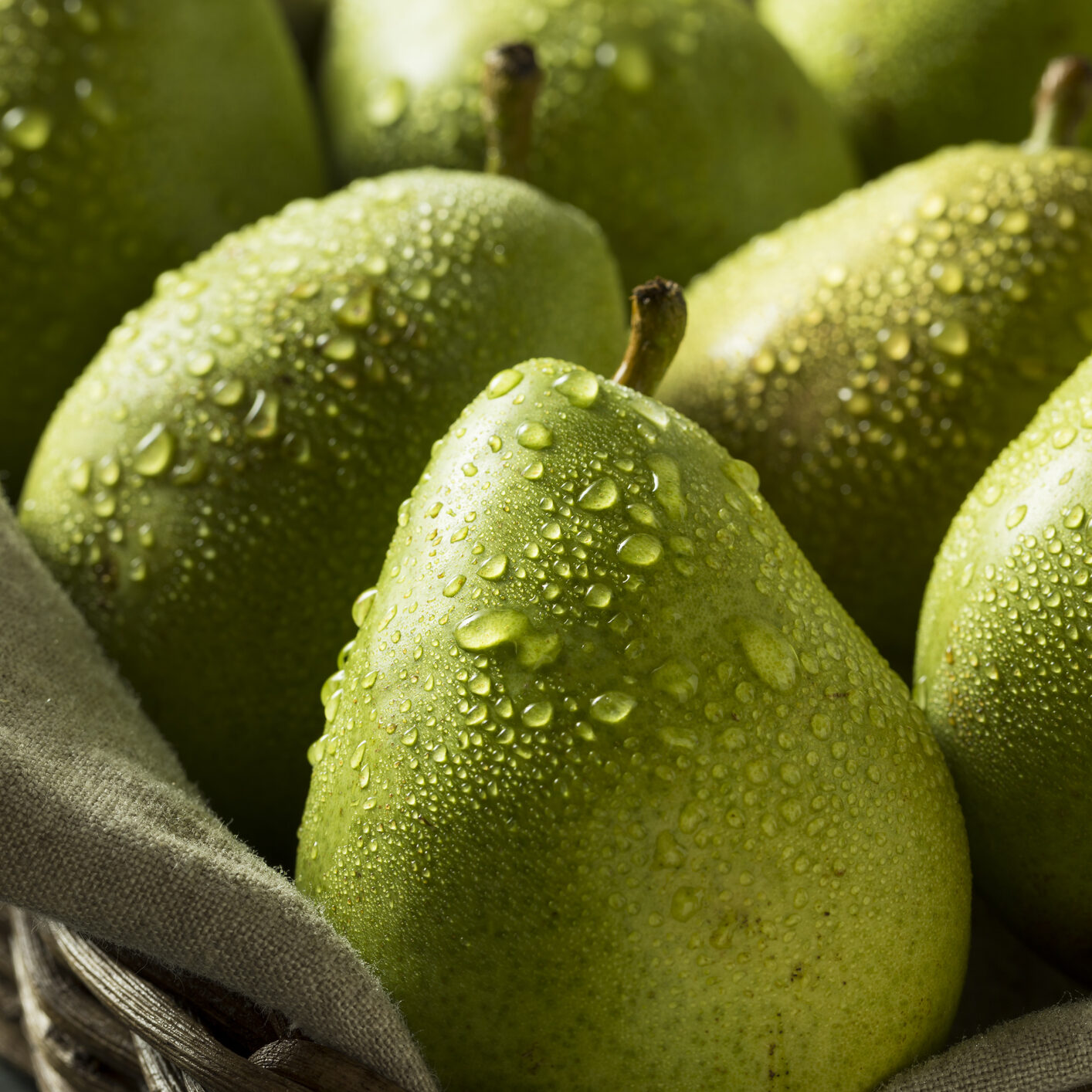Pair up with a Pear.

This the Sickles Market Guide to Pears!
Now that the holiday season upon us it is time to talk again about the most underrated fruit, the pear! The pear is native to coastal and mildly temperate regions of the old World, from Western Europe and North Africa east across Asia. Pear cultivation in cool, temperate climates extends to the remotest antiquity, and evidence exists of its use as a food since prehistoric times. Pears were cultivated in China as early as 2000 BC. The word “pear”, or its equivalent, occurs in all the Celtic languages, while in Slavic and other dialects, differing appellations, still referring to the same thing, are found.The pear was also cultivated by the Romans, who ate the fruits raw or cooked, just like apples.
Pears and apples cannot always be distinguished by the form of the fruit; some pears look very much like some apples, e.g. the nashi pear. One major difference is that the flesh of pear fruit contains stone cells. Pears ripen from the inside out, the best way to check for ripeness is to “check the neck.” To do this, gently press near the stem with your thumb. When it gives to gentle pressure it is ripe, juicy, and ready to eat. If you wait until the pear is soft around the middle, then it will be overripe.
What ties pears to the holiday seasons in a classic song of the Holiday seasons. “The Twelve Days of Christmas” is an English Christmas carol that enumerates in the manner of a cumulative song a series of increasingly grand gifts given on each of the twelve days of Christmas. The song, published in England in 1780 without music as a chant or rhyme, is thought to be French in origin. Since 1780 the first gift has always been “A partridge in a pear tree.” The standard tune now associated with it is derived from a 1909 arrangement of a traditional folk melody by English composer Frederic Austin, who introduced the familiar prolongation of the verse “five gold rings” (now often “five golden rings”).
Here are some different types of Pears we have at Sickles Market
Bartlett (BART-let)
Signature sweet pear flavor and aroma with abundant juice. In season August – February. Try a sliced Bartlett atop a garden green salad with your favorite dressing. Or, simply serve freshly sliced Bartlett wedges with cheese for an appetizing snack.
Starkrimson (star-KRIM-son)
Aromatic, juicy, and sweet with floral essence. In season August – November. Slice them fresh into salads, bowls of cereal, or to accompany charcuterie for an indescribably gorgeous pop of color!
Bosc (BAHsk)
Crisp and woodsy with a honey sweetness. In season September – April. They are ideal for use in baking, broiling or poaching. They retain their shape and texture better than other varieties, and their flavor is less likely to be overwhelmed by the use of strong spices like cinnamon, clove or nutmeg.
Danjou (ON-ju)
Refreshingly sweet and juicy with a hint of citrus. In season October – July. Their dense flesh holds up well in heated applications like baking, poaching, roasting, or grilling and they are delicious when sliced fresh in salads or eaten as an out-of-hand snack.
Forelle (for-EL)
Crisp, tangy and refreshingly sweet. In season September – January. Forelles are a good choice as snacking pears. They are very sweet, with a flesh that is slightly firmer than most other pears. Their size, festive appearance, and naturally sweet flavor make Forelles a winner in children’s lunch boxes.
Comice (ko-MEESE)
Succulent, buttery, and exceptionally sweet.In season September – February. The sweet buttery flesh of Comice can find no better compliment than when served with cheese, especially soft ripened cheeses like Brie, Camembert, or any of the blues.
Seckel (SEK-el)
Bite-sized, crunchy, and ultra-sweet. In season September – February. Seckels are small enough to be canned whole. Jars of “baby-pear” Seckels are charming as gifts.
Here are some cheese PEARings to go along with those Pears!
Schwingerkase – Central Switzerland -Raw Cow Milk
Similar to Challerhocker, Enzian, Gruyere. Taste: buttery, fruity, floral undertone Texture: firm, satiny.
Rush Creek Reserve – Dodgeville, Wisconsin – Raw Autumnal Cow Milk
Similar to Vacherin Mont d’Or, Winnimere. The taste is bacon-like, rich, savory. Texture is soft, silky, fondue-like (when baked).
Bleu des Basques – Pyrenees, France – Thermalized Sheep Milk
For those in search of a blue like Roquefort but a touch more delicate, feast on Bleu des Basques, Mellow but characterful, Bleu des Basques’ flavor is a perfect balance of fruity, mineral and olivey notes. Its texture is rich and buttery, almost to the point of decadence.
Monte Sibillini – Marches, Italy – Raw Sheep Milk
A compact, pale yellow Pecorino with a rich, persistent flavor. It’s somewhat herbaceous, and that’s down to a thyme infusion in the curds during the cheese’s early production stages. Quite nice with a drizzle of chestnut blossom honey.
Langres – Champagne, France – Cow Milk
Langres is the ultimate ‘party’ cheese, for on top of its small cylindrical body sits a well on which to pour champagne. The cheese itself is wonderful. Its texture is dense and flinty and its flavors are buttery and salty, with a slightly tart, lactic finish.
QUICKES CHEDDAR – MID DEVON, ENGLAND COW MILK
Aged upwards of 12 months, Quickes Traditional Mature Cheddar is sharp and bitey, with long lingering grassy and chivey flavors. Its paste is dense and crumbly.

